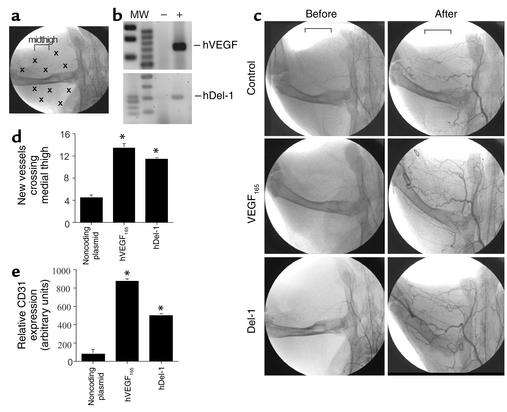Figure 2.
Del-1 induces angiogenesis in rabbit model of ischemia. (a) Angiography was performed after unilateral hind-limb ischemia induced in New Zealand white rabbits (3–4 kg body weight) by surgical resection of the femoral artery (19). X’s indicate the ten sites in and surrounding the medial thigh (midthigh) (bracket) in the upper leg, where plasmid was injected (0.5 mg/site). (b) Sustained transgene expression induced by plasmid injection in muscle was detected 1 month after therapy by RT-PCR for hVEGF165 and hDel-1. VEGF or Del-1 gene expression was detected in VEGF- or Del-1–plasmid–injected muscle, respectively, but not in control plasmid–injected muscle. MW, molecular weight standards. (c) Angiography was performed before and 1 month after therapy for each treatment. Brackets indicate medial thigh region. (d) Mean number of new vessels (± SD) crossing the medial thigh (area under the brackets in c) for each treatment 1 month after therapy. Asterisks indicate statistically significant result (P < 0.01). (e) Mean CD31 protein expression (± SD) in muscle tissue 1 month after therapy. CD31 levels within injected muscle were assessed by Western blot analysis of lysates of muscle tissue. Asterisks indicate statistically significant result relative to noncoding plasmid control (P < 0.01). Statistical significance for angiography and CD31 analyses was assessed by one-way ANOVA with plasmid treatment as the main effect.

